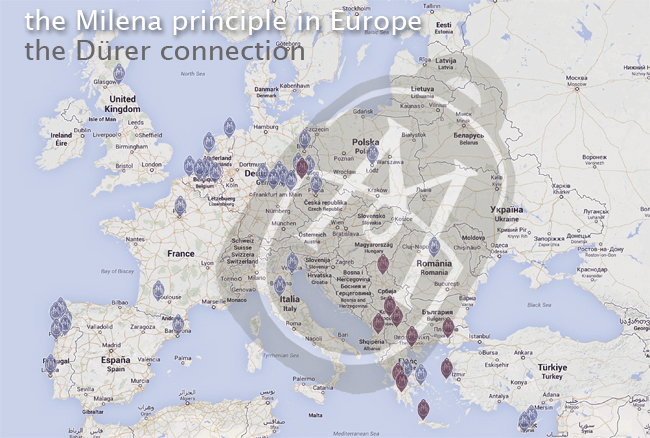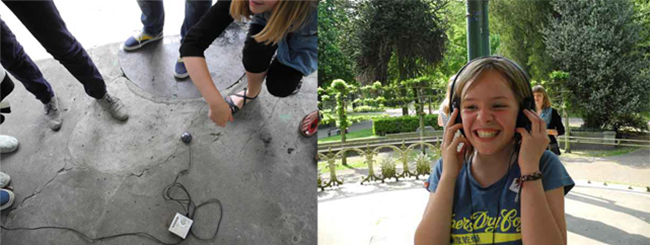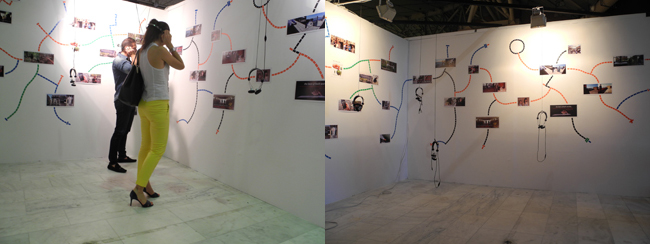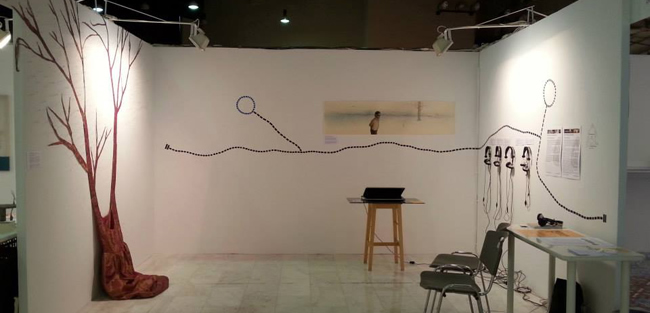
the Milena principle : Introduction

The Milena Principle | A Nomadic Platform for Art and Thought
About Us
The Milena Principle is an independent European think tank with a global outlook. It brings together artists and experts from diverse fields — including science, ecology, alternative medicine, literature, art history, sound art, architecture, technology, and philosophy. We distinguish ourselves through unconventional, nomadic approaches that spark unexpected dialogues in art.
[Source: Curator Artemis Potamianou — MoMA New York & Tate London UK — Art Athina 2014
![]()
Human Capital
Operating across Europe, The Milena Principle organizes interdisciplinary projects where international artists, writers, and scientists collaborate. Our work explores the intersections of culture, science, ecology, and health, and is grounded in personal research by our members.
We invest in Human Capital — nurturing individual growth, critical thinking, and meaningful exchange across borders and disciplines. Over the past decade, we have developed a strong network of partners in over 15 countries, built on personal connections rather than institutional funding. Most of our initiatives are realized through voluntary collaboration and minimal financial support.

![]()
A Nomadic Museum
Our events are not traditional exhibitions but dynamic, process-driven spaces — "laboratories of feeling-thinking" — where art functions as a tool for knowledge and transformation. These pop-up events invite public participation and foster intimate, human-centered encounters.
Inspired by the nomadic spirit of Renaissance artists, our projects emphasize connection, dialogue, and shared curiosity. Like those early thinkers, we believe in creating networks of solidarity through exchange — envisioning new futures grounded in creativity and human connection.

![]()
The Dürer Connection
The Milena Principle draws inspiration from Albrecht Dürer’s 1520 journey through the Low Countries, reimagining this Renaissance tradition for the present.
Dürer and his peers — artists, scientists, and philosophers — crossed both physical and intellectual borders, exchanging ideas and forming lasting connections. Our ongoing initiative, The Dürer Connection, embodies this legacy. Since 2003, it has grown into a nomadic European network linking artists, scholars, and communities through collaborative projects and philosophical exploration.
From Belgium to the Balkans, and Latin America to Central Europe, our events celebrate art as a vehicle for utopia, dialogue, and shared humanity.
![]()
Mapping our working space

Amsterdam - Antwerp - Athens -Barcelona - Belgrado - Berlin - Beveren - Braga - Brasilia - Bruges - Chania - Chemnitz - Chios - Delphi - Dimitsana - Dresden - Edinburgh - Essen - Florence - Ghent - Guimaraes - Jahnishausen - Kassel - La Romieu - Leipzig - Limassol - Lisbon - Lodz - Ljubljana - Naumburg - Neo Chorio - New York - Nicosia - Nieuwolda - Paris - Patras - Porto - Prague - Prespa - Prishtina - Santiago de Compostela - Sint-Niklaas - Skopje - Soufi - Thessaloniki - Tinos - Tirana - Tirgu Mures - Tongeren - Venice - Vigo - Weimar
![]()
An Independent Art Platform
Curator Artemis Potamianou (MoMA New York & Tate London), currently based in Athens, selected The Milena Principle as one of the 49 most important independent art platforms worldwide. These platforms distinguish themselves through unconventional practices and by initiating unexpected, influential debates around art and its role in society. Rather than competing with their surroundings, they act in dialogue with them — grounded in the principle that “unity is strength.”
The Milena Principle was selected for the Platforms Project at ART-ATHINA 2014-2015-2016-2018, curated by Artemis Potamianou.
Our approach is defined by a deep vision of the body as an instrument of both art and knowledge. Principles such as serenity, silence, intimacy, enchantment, and inspiration guide our work — both in concept and in practice.
We ask essential questions:
– What could an ecological art of living look like?
– How can we arrive there? What behaviours must we change?
– What can we contribute as individuals?
– What new interpretations and frameworks are needed in today’s world?
As French writer André Gide — Nobel Prize for Literature, 1947 — once wrote: "I have no use for knowledge that has not been preceded by a sensation."This philosophy resonates deeply in our projects, where knowledge arises not from theory alone, but through embodied experience, sensory awareness, and artistic exploration.

![]()
The Politics of the Heart
A Multidisciplinary Space for Community and Imagination
At The Milena Principle, we approach politics not as a mechanism of power or control, but as a poetic and deeply human force — a space for imagination, solidarity, and meaningful connection.
As “nomads of a new era,” we navigate the intersections of art, ecology, philosophy, and politics, guided by utopian thinking and the belief that imagination can drive transformation. Concepts like togetherness and solidarity are not abstract ideals for us — they are active, generative forces.
Our projects bring together people from diverse disciplines, cultures, and ideologies to experiment, collaborate, and envision alternative ways of living and working. In the face of ecological and social crises, we believe new forms of alliance are urgently needed — not just among institutions or experts, but across all layers of society and beyond national borders.
Through our events, we explore innovative models of collaboration and ask vital questions:
How can we bridge difference and misunderstanding?
What new literacies and skills are needed to respond to today’s challenges?
Can we reimagine what it truly means to live well?
The promises of the industrial age — that growth equals happiness — have proven hollow. Instead, we seek a slower, more connected, and more meaningful art of living: one rooted in care, creativity, and human connection.

![]()
Silence as an Instrument of Experience
Growing Silence is a multidisciplinary project that explores the role of silence and space within the urban environment. It approaches silence not as a physical or acoustic absence, but as a phenomenological experience — deeply tied to how we perceive, feel, and move through city life.
Here, silence becomes both a mode of experience and a form of knowledge.
Instead of measuring silence in decibels, the project asks: How is silence felt? How does it affect our mental and emotional states? How can it counterbalance the relentless pace of modern cities? Through artistic interventions, Growing Silence reconnects silence with urban space — offering it as a form of inner refuge and a vital, breathing presence in public life.

The project also seeks to bridge the outer manifestations of silence — in natural or historical soundscapes — with its inner, subjective experience. In doing so, silence becomes part of our shared cultural memory and part of an active, lived city.
A central focus of Growing Silence is its engagement with younger generations — students, emerging artists, and future urban residents. They are invited to co-create and reflect on the role of silence in their environments, and to imagine new urban futures where silence is embraced as a meaningful design principle.
This is not only a cultural or artistic inquiry — it is also a practical one:
How can urban design invite or preserve silence?
What architectural or artistic tools can create space for silence?
How can silence support a more inclusive, human-centered urban experience?
In an age of constant noise — digital, social, and environmental — Growing Silence invites us to listen more deeply, to design more consciously, and to reimagine the city as a place where silence still belongs.



Working with the sound artists of Escoitar (Spain).
Xoán-Xil López, Horacio González Diéguez, Enrique Tomas
Escoitar.org is a collective of artists, anthropologists, engineers, developers and musicologists focusing in the aural phenomena. Considering the experience of sound as a means of gathering information, they aim to reflect upon the acoustic forms of sociability, rethinking the urban landscape and social relationships.
![]()
Amplified Gestures
Reclaiming the Acoustic Dimension of Public Space
In the development of public spaces, the acoustic dimension is too often overlooked. Urban environments are increasingly dominated by noise — sounds without social meaning, sonic clutter that disrupts our ability to feel connected to the spaces we inhabit.
This sensory disconnection weakens our sense of place, belonging, and identity. It reduces the quality of life and erodes the subtle relationships we form with our environment.
Amplified Gestures calls attention to the urgent need to rethink how sound — and its absence — is treated in urban planning, architecture, and the management of public space. The way we understand ourselves, our self-awareness, and the relationships we build with others are inextricably tied to the spaces we move through. And sound is a key part of that relationship.
We all exist somewhere. And who we are is shaped by where — and how — we exist. If we want to create livable, meaningful, and inclusive cities, we must begin to listen more carefully. This means not only reducing harmful noise but also cultivating acoustic environments that support social interaction, contemplation, and well-being.
Utopia Book [version IV] Platform Projects | Independent Art Fair Athens 2018.

Presentation of the Utopia Book at Platform Projects [the Independed Art Fair] School of Fine Arts Athens 2018. Booth 29 the Milena principle. Curated by Artemis Potamianou (Moma NY & Tate London)
Utopia | Just Around the Corner
A silent group walk through cityscapes and inner landscapes
A silent group walk — moving gently, intuitively, through cities like Nicosia, Brussels, and New York. There is no goal, no destination. The only intention: to get lost.
Each participant carries a book — a book inspired by Thomas More's Utopia, yet containing only one word: "Utopia". This book is not meant to be read in the traditional sense. It resembles a walk: non-linear, open from different angles, with pages folded into pages, a structure that invites exploration rather than explanation.
It is a book to be shared, not studied — to be passed spontaneously between the walkers, to be carried in silence, and opened not at random, but in response to the places that appear — as if the city itself asks to be read.
These moments become opportunities:
– to read the place
– to read the others
– to read the moment in which they now stand.
Utopia (Just Around the Corner) is an invitation to wander, to listen, to notice. To lose your way, in order to find something else.

Recognition by Curator Artemis Potamianou and the Platforms Project
Curator Artemis Potamianou (MoMA New York & Tate London), currently based in Athens, has recognized The Milena Principle as one of the 49 most important independent art platforms worldwide. These platforms distinguish themselves through unconventional approaches and by fostering unexpected and influential debates on art. Guided by the principle of “unity is strength,” they have established a distinct presence on the international art stage—without opposing the communities and environments they serve.
In 2018, Artemis Potamianou and the selection committee of the Platforms Project further honored The Milena Principle by naming it one of 40 representative art platforms worldwide invited to showcase their work and collaborations in Lisbon and Athens.
Together with allied collectives and organizations in Lisbon and Athens, The Milena Principle presented a collaborative sound and visual installation. This work explored the impact of artistic interventions across cities by engaging remote participants from diverse urban environments. The juxtaposition of these interventions emphasized the coherence found in everyday urban rituals and practices, highlighting shared human experiences rather than focusing on geographical or cultural differences.

the Milena principle at ART-ATHINA Patforms Project Athens Greece 26>29 May 2016.
Art-Athina 2014-2015-2016. Faliro Pavilion (TaeKwonDo Stadium) Athens.

the Milena principle at Art Athina 2014, 2015 & 2016: our Nomadic Museum 2000-2016

The Milena principle Stand Art Athina 2016.The Milena principle Stand Art Athina 2016.
Public Talk about sound art by Andromachi Vrakatseli B in our stand at Art Athina 2016. With Georgos Samantas, Nicos Bubaris, Andromachi Vrakatseli B, Ioannis Vandoulakis, Geert Vermeire & Sinan Bökesoy.

Platforms Project
The Athens Art Fair selected 49 of the most important independent art platforms from around the world—platforms that stand out through their unconventional approaches and their ability to spark unexpected and influential debates on art. Guided by the principle “unity is strength,” these platforms have carved out a unique space on the international art stage while maintaining respectful relationships with the communities and environments they engage.
Through continuous journeys and exchanges of ideas, this network cultivates solidarity and affinity. The Dürer Connection embraces a utopian and humanistic spirit, using travel as an artistic tool. Since its inception, the project has brought events and exhibitions to countries across Europe, including Germany, the Netherlands, Portugal, Poland, Spain, Italy, the Czech Republic, Romania, Austria, Serbia, Slovenia, Bosnia and Herzegovina, Albania, Kosovo, North Macedonia, Greece, and Crete. Parallel events have also taken place in Latin America, while artists and participants from many European countries have been brought together in Belgium.
![]()

The Path of Dürer
Travel as Artistic Instrument
At the heart of The Milena Principle lies The Dürer Connection — an ongoing nomadic project and European network launched in 2003. Inspired by the spirit of the Flemish Renaissance, it echoes a time when artists, philosophers, and scientists journeyed across borders, exchanging ideas and building lasting connections.
This project transforms travel into a form of artistic practice — a catalyst for solidarity, collaboration, and cultural exchange. Through exhibitions, street actions, and participatory events, The Dürer Connection has taken root in cities across Europe — from Germany, the Netherlands, and Italy to the Balkans, Greece, and beyond — as well as in Latin America, often bringing diverse communities together in Belgium.
An Artistic Journey of Care and Connection
The Path of Dürer extends this vision by focusing on participatory art in places that call for care and attention. It views the city as a living organism, shaped by its people, and treats movement through urban space as a mobile laboratory — where minimal, subtle interventions create opportunities for reflection and change.
As artist-nomads working at the intersection of art, ecology, and politics, we initiate international exchanges that are grounded in utopian thinking and poetic action. A central element in these street interventions is The Table — a symbol of encounter, dialogue, and shared purpose.

Our guiding question is:
What if art could become a platform for shaping society — using politics as a poetic, creative, and human force?
We embrace the challenges that come with collaboration across diverse cultures, disciplines, and worldviews. Our work explores practical strategies to foster understanding, co-creation, and collective action.
At the core of our practice are the values of solidarity, connection, and togetherness — supported by a multidisciplinary collective of artists and experts from fields such as science, philosophy, alternative health, literature, music, sound art, art history, architecture, and technology.
The Milena Principle centers its work on the ongoing traveling project “The Dürer Connection” (since 2003), which has evolved into a European nomadic network. This initiative fosters collaborative encounters between the public, experts, and artists, inspired by the spirit of the Flemish Renaissance — a time when artists, philosophers, and scientists traveled relentlessly, building connections across people and places.
Through the continuous exchange of ideas and journeys, the project creates a network of solidarity and affinity.
Rooted in this utopian and humanistic vision, The Dürer Connection uses travel as an artistic instrument. Since its inception, it has organized events and exhibitions throughout Europe, including Germany, the Netherlands, Portugal, Poland, Spain, Italy, the Czech Republic, Romania, Austria, Serbia, Slovenia, Bosnia and Herzegovina, Albania, Kosovo, North Macedonia, Greece, and Crete. Parallel events have also taken place in Latin America, while bringing artists and participants from various European countries together in Belgium.
![]()


